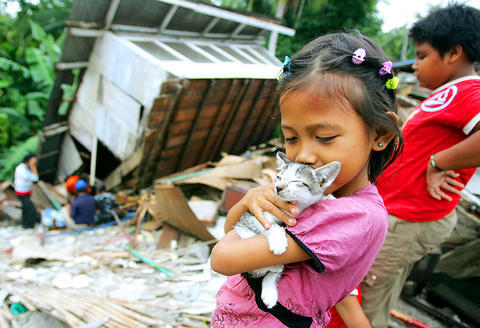AP, PADANG, Indonesia
Three powerful earthquakes jolted Indonesia in less than 24 hours, sending a 3m tsunami crashing to shore, damaging hundreds of houses and terrifying residents. At least 10 people were killed in the tremors, which were followed by dozens of aftershocks.
One Australian seismologist said the region was fortunate to have escaped a tragedy, such as the 2004 tsunami that killed more than 230,000 people in a dozen nations.

PHOTO: AP
The 8.4-magnitude quake that shook Southeast Asia on Wednesday was the strongest this year. But the huge force of water it spawned was pushed to sea rather than land, said Mike Turnbull of Central Queensland University.
"It's a quirk of nature that this is how it happened," he said. "It could have quite easily have been the other way."
A towering wave slammed into at least one village on Sumatra, the island that was ravaged in 2004, sweeping a dozen houses out to sea. Smaller waves were recorded further down the coast.
Rukhlan, a 43-year-old fisherman, said residents in Muara Maras were horrified when they saw the ocean retreat and then fire back to shore.
"I heard people screaming and yelling tsunami ... tsunami!" he said, adding that the water flooded the village and damaged dozens of homes. "Then I ran to find my children, but they had already run to the hills."
Two other powerful tremors -- magnitudes 7.8 and 6.2 -- followed yesterday in western and eastern Indonesia, the US Geological Survey (USGS) said. Several tsunami warnings were issued and later lifted.
The worst destruction was caused by the jolts along the coast, especially in the city of Padang, 185km from the epicenter.
"At least five large buildings -- including mosques, houses and a school -- collapsed," said Surya Budhi, who was overseeing emergency response in the area, and rescuers were searching for survivors at a badly damaged car dealership.
A fire also broke out on the fourth floor of a shopping mall.
Rafael Abreu, a geologist with the USGS, said yesterday's first quake off Sumatra island did not appear to be an aftershock to the more powerful temblor the day before. But the centers of both were close together.
"It's fairly large itself," Abreu said. "It seems to be a different earthquake."
Yulinar, who lives with her fisherman husband and five children in a wooden shack at a waterfront market in Padang, said the second quake, which struck at 6:49am at a depth of just 10km, was so powerful the family had to grab onto furniture to keep from being hurled to the ground.
"It was very bad," said Yulinar, who fled inland with her family after a warning from the mayor was broadcast through mosque speakers. "I was so scared the tsunami was coming."
The third quake struck at 4:48pm off Sulawesi island, a different fault line. It was centered 310km northeast of Manado, Sulawesi at a depth of 20km, the USGS said.
More than 30 aftershocks have rattled the region in the last day and many people refused to return to their homes, fearing a repeat of the 2004 tsunami off Sumatra, which bore the brunt of that disaster. Nearly two-thirds of the deaths occurred in nearby Aceh Province.
The triple quakes served as a reminder of the awesome seismic forces that lies beneath the Indonesian archipelago of 235 million people.

People can preregister to receive their NT$10,000 (US$325) cash distributed from the central government on Nov. 5 after President William Lai (賴清德) yesterday signed the Special Budget for Strengthening Economic, Social and National Security Resilience, the Executive Yuan told a news conference last night. The special budget, passed by the Legislative Yuan on Friday last week with a cash handout budget of NT$236 billion, was officially submitted to the Executive Yuan and the Presidential Office yesterday afternoon. People can register through the official Web site at https://10000.gov.tw to have the funds deposited into their bank accounts, withdraw the funds at automated teller

PEACE AND STABILITY: Maintaining the cross-strait ‘status quo’ has long been the government’s position, the Ministry of Foreign Affairs said Taiwan is committed to maintaining the cross-strait “status quo” and seeks no escalation of tensions, the Ministry of Foreign Affairs (MOFA) said yesterday, rebutting a Time magazine opinion piece that described President William Lai (賴清德) as a “reckless leader.” The article, titled “The US Must Beware of Taiwan’s Reckless Leader,” was written by Lyle Goldstein, director of the Asia Program at the Washington-based Defense Priorities think tank. Goldstein wrote that Taiwan is “the world’s most dangerous flashpoint” amid ongoing conflicts in the Middle East and Russia’s invasion of Ukraine. He said that the situation in the Taiwan Strait has become less stable

REASSURANCE: The US said Taiwan’s interests would not be harmed during the talk and that it remains steadfast in its support for the nation, the foreign minister said US President Donald Trump on Friday said he would bring up Taiwan with Chinese President Xi Jinping (習近平) during a meeting on the sidelines of the APEC Summit in South Korea this week. “I will be talking about Taiwan [with Xi],” Trump told reporters before he departed for his trip to Asia, adding that he had “a lot of respect for Taiwan.” “We have a lot to talk about with President Xi, and he has a lot to talk about with us. I think we’ll have a good meeting,” Trump said. Taiwan has long been a contentious issue between the US and China.

Japanese Prime Minister Sanae Takaichi yesterday lavished US President Donald Trump with praise and vows of a “golden age” of ties on his visit to Tokyo, before inking a deal with Washington aimed at securing critical minerals. Takaichi — Japan’s first female prime minister — pulled out all the stops for Trump in her opening test on the international stage and even announced that she would nominate him for a Nobel Peace Prize, the White House said. Trump has become increasingly focused on the Nobel since his return to power in January and claims to have ended several conflicts around the world,